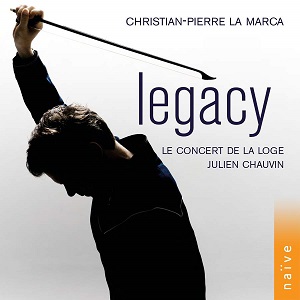
Legacy
Joseph Haydn (1732-1809)
Cello Concerto No. 1 in C major (1760s)
Nicola Porpora (1686-1758)
Largo from Cello concerto in G major
Wolfgang Amadeus Mozart (1756-1791)
Sinfonia Concertante for violin, viola, cello and orchestra in A major, Anh104 (1779, completion by Robert Levin)
Christoph Willibald Gluck (1714-1787)
Dance of the Blessed Spirits, from Orphée et Eurydice
Nicola Porpora
Giusto amor, tu che m’accendi from Gli orti esperidi
Joseph Haydn
Cello Concerto No. 2 in D major (1783)
Christian-Pierre La Marca (cello)
Philippe Jaroussky (counter-tenor)
Adrien La Marca (viola)
Le Concert de la Loge/Julien Chauvin (violin)
rec. 2021, Temple du Saint Esprit, Paris
Naïve V7259 [72]
In 2019, I reviewed very positively an Aparté recording by the French period orchestra Le Concert de la Loge, directed by Julien Chauvin. When I requested this new CD, it didn’t occur to me that it was by the same artists – I was more focussed on the Haydn concertos as the reason for wanting to review it – so when I unwrapped the package and saw the orchestra’s name, I was delighted.
The Haydn concertos, when paired together, present something of a problem in that they only occupy about 45 minutes, and thus need some couplings. I have seen various approaches to this, usually concertos of a similar era, though occasionally with cello works of a very different style (e.g. Hindemith’s Trauermusik). The approach taken on Legacy is somewhat different, with two works – the Gluck and the Porpora aria – seemingly outside the usual concertante scope. It should be noted that both works feature considerable solo parts for the cello, the Gluck being a transcription by Christian-Pierre La Marca, a French cellist whose name was unfamiliar to me. In the booklet notes, he describes the rationale behind the programme as wanting to “show the connecting links, the filiations that through the cello repertory during the era of Viennese Classicism”. Porpora employs and influences Haydn, Haydn mentors Mozart; clearly the links are there. Gluck is somewhat more of an awkward fit. He is included supposedly because his music introduced Viennese classicism to the French.
Let me consider the two main works first. The Haydn concertos are my favourite in the genre, and I have reviewed quite a few now for MWI. My favourite recording of a pairing of the concertos has been Daniel Müller-Schott with the Australian Chamber Orchestra (Orfeo – review); Jean-Guihen Queyras (Harmonia Mundi – review) is very fine as well. As far as single concerto performances go, my standout is, without question, that of the C major by Asier Polo (IBS Classical – review). So how do these performances by La Marca compare? His playing is very good, though not quite as characterful as that of the others I have mentioned. However, the overall performances are elevated by the exceptional contribution of the orchestra, aided in no small part by a very natural recording. I was exceptionally impressed by them in the Haydn symphony disc mentioned at the start; this recording only reinforces that opinion. There is a clarity of expression, together with an obvious joy in performance that really shines through. The net effect is to take La Marca’s very good playing and make it sound great.
The other works are all unfamiliar, and thus interesting because of their novelty. I presume the decision to only include the slow movement from Porpora’s concerto was to do with the programme’s balance, as the whole work would have fitted (just) on the CD. It is not known when the concerto was written, but it is clearly of an earlier time than the Haydns. The Largo is given an intense and soulful reading.
I am completely outside my area of experience with the Porpora aria. I, of course, knew of Philippe Jaroussky’s reputation as one of the outstanding counter-tenors currently working, but had not heard him sing. I was amazed by his range: I had no idea that a man’s voice could possibly reach so high and remain musical.
Mozart’s unfinished Sinfonia Concertante is perhaps the most intriguing work on the disc. I was unaware of its existence, though a quick check of Presto indicates there are a few recordings available. Robert Levin’s completion dates to 1969; there have been a few other attempts at adding to the 164 bars of orchestral introduction (about 2 minutes), using the sketches Mozart left. The piece presented here is a little under ten minutes, so presumably comprises the intended first movement. If you are like me, and have not heard this before, don’t build up your hopes for something of the quality of the work of genius that is the Sinfonia Concertante for Violin and Viola, K364. Without doubt, there are hints of it in K320, presumably a combination of Mozart’s thoughts and Levin’s inspirations.
The well-known Gluck piece, in the unfamiliar guise of cello as dominant instrument, is the least convincing piece on the disc. In its usual form, the flutes give it an ethereal quality, which the transcribed version does not match; indeed, I felt the lower register of the cello changed the feel entirely, and not for the better.
As mentioned, the recording is excellent, and the notes, which include a “conversation” between soloist and conductor, are good.
My takeaway from this disc is just how good Le Concert de la Loge is, and that I really should track down their earlier recordings. Christian-Pierre La Marca is unquestionably a gifted cellist, but he is outshone by the orchestra here.
David Barker
Help us financially by purchasing from





















